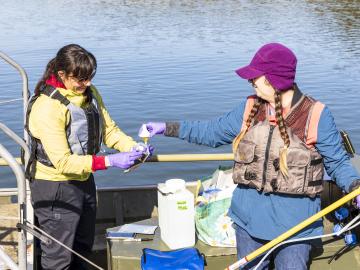
Filter News
Area of Research
- (-) Biology and Environment (30)
- (-) Computer Science (3)
- (-) Materials (55)
- Advanced Manufacturing (2)
- Electricity and Smart Grid (1)
- Energy Science (68)
- Energy Sciences (1)
- Functional Materials for Energy (2)
- Fusion and Fission (6)
- Fusion Energy (2)
- Isotopes (6)
- Materials for Computing (9)
- National Security (21)
- Neutron Science (14)
- Nuclear Science and Technology (6)
- Quantum information Science (3)
- Supercomputing (52)
News Topics
- (-) Artificial Intelligence (10)
- (-) Computer Science (19)
- (-) Cybersecurity (3)
- (-) Energy Storage (23)
- (-) Isotopes (3)
- (-) Materials (28)
- (-) Microscopy (14)
- (-) Security (2)
- 3-D Printing/Advanced Manufacturing (10)
- Advanced Reactors (2)
- Big Data (5)
- Bioenergy (19)
- Biology (30)
- Biomedical (10)
- Biotechnology (4)
- Buildings (2)
- Chemical Sciences (15)
- Clean Water (4)
- Composites (3)
- Coronavirus (10)
- Critical Materials (5)
- Environment (35)
- Exascale Computing (4)
- Frontier (3)
- Fusion (1)
- Grid (5)
- High-Performance Computing (10)
- Hydropower (5)
- Machine Learning (8)
- Materials Science (40)
- Mathematics (1)
- Mercury (2)
- Molten Salt (1)
- Nanotechnology (20)
- National Security (3)
- Neutron Science (16)
- Nuclear Energy (4)
- Partnerships (4)
- Physics (12)
- Polymers (8)
- Quantum Science (6)
- Simulation (2)
- Summit (8)
- Transportation (5)
Media Contacts

Muralidharan was recognized for “a highly prolific spirit of innovation in creating or facilitating outstanding inventions that have made a tangible impact on the quality of life, economic development and welfare of society.”

Researchers at Oak Ridge National Laboratory are using a novel approach in determining environmental impacts to aquatic species near hydropower facilities, potentially leading to smarter facility designs that can support electrical grid reliability.

Three ORNL scientists have been elected fellows of the American Association for the Advancement of Science, or AAAS, the world’s largest general scientific society and publisher of the Science family of journals.

A team of scientists led by the Department of Energy’s Oak Ridge National Laboratory and the Georgia Institute of Technology is using supercomputing and revolutionary deep learning tools to predict the structures and roles of thousands of proteins with unknown functions.

Neuromorphic devices — which emulate the decision-making processes of the human brain — show great promise for solving pressing scientific problems, but building physical systems to realize this potential presents researchers with a significant

Six scientists at the Department of Energy’s Oak Ridge National Laboratory were named Battelle Distinguished Inventors, in recognition of obtaining 14 or more patents during their careers at the lab.

Six ORNL scientists have been elected as fellows to the American Association for the Advancement of Science, or AAAS.

The annual Director's Awards recognized four individuals and teams including awards for leadership in quantum simulation development and application on high-performance computing platforms, and revolutionary advancements in the area of microbial

Scientists from Oak Ridge National Laboratory used high-performance computing to create protein models that helped reveal how the outer membrane is tethered to the cell membrane in certain bacteria.

Popular wisdom holds tall, fast-growing trees are best for biomass, but new research by two U.S. Department of Energy national laboratories reveals that is only part of the equation.


